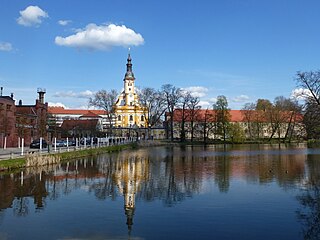
Brandenburg, officially the State of Brandenburg, is a state in northeastern Germany. Brandenburg borders Poland and the states of Berlin, Mecklenburg-Vorpommern, Lower Saxony, Saxony-Anhalt, and Saxony. It is the fifth-largest German state by area and the tenth-most populous, with 2.5 million residents. Potsdam is the state capital and largest city. Other major towns are Cottbus, Brandenburg an der Havel and Frankfurt (Oder).

The Havel is a river in northeastern Germany, flowing through the states of Mecklenburg-Vorpommern, Brandenburg, Berlin and Saxony-Anhalt. The 325 kilometres (202 mi) long Havel is a right tributary of the Elbe. However, the direct distance from its source to its mouth is only 94 kilometres (58 mi). For much of its length, the Havel is navigable; it provides an important link in the waterway connections between the east and west of Germany, as well as beyond.
Märkisch-Oderland is a Landkreis (district) in the eastern part of Brandenburg, Germany. Neighboring this district are the district of Barnim, the country of Poland, the district-free city of Frankfurt (Oder), the district of Oder-Spree and the Bundesland of Berlin. The administrative seat is the town of Seelow but the largest town is Strausberg.

The Neumark, also known as the New March or as East Brandenburg, was a region of the Margraviate of Brandenburg and its successors located east of the Oder River in territory which became part of Poland in 1945 except some villages of former districts of Königsberg in the New March and Weststenberg remained in Germany.

Schwedt is a town in Brandenburg, in northeastern Germany. With the official status of a Große kreisangehörige Stadt, it is the largest town of the Uckermark district, located near the river Oder, which forms the border with Poland.

Neuzelle is a municipality in the Oder-Spree district of Brandenburg, Germany, the administrative seat of Amt Neuzelle. It is best known for Cistercian Neuzelle Abbey and its Neuzeller Kloster Brewery.

Lower Lusatia is a historical region in Central Europe, stretching from the southeast of the German state of Brandenburg to the southwest of Lubusz Voivodeship in Poland. Like adjacent Upper Lusatia in the south, Lower Lusatia is a settlement area of the West Slavic Sorbs whose endangered Lower Sorbian language is related to Upper Sorbian and Polish.

Bad Freienwalde is a spa town in the Märkisch-Oderland district in Brandenburg, in north-eastern Germany.

Müllrose is a town in the Oder-Spree district, in Brandenburg, in eastern Germany. It is situated on the Oder-Spree Canal, 15 km southwest of Frankfurt (Oder). A part of the town is located in the Schlaube Valley Nature Park, named after the Schlaube, a 20 kilometres long river.

Woltersdorf is a municipality in the Oder-Spree district in Brandenburg. It is often referred to as "near Berlin" or "near Erkner" as there are a number of other places bearing the same name in Germany.

Schlaube Valley Nature Park is a nature park and reserve in the state of Brandenburg, Germany. It covers 225 square kilometres (87 sq mi). It was established on December 27, 1995.

Mitte is a central section of Berlin, Germany, in the eponymous borough of Mitte. Until 2001, it was itself an autonomous district.

The Lower Oder Valley International Park is a shared German-Polish nature reserve. It comprises the western banks of the Oder river within the Uckermark district in the German state of Brandenburg as well as the steep eastern banks in the Gryfino and Police counties of the Polish West Pomeranian Voivodeship further north.

Alte Oder is a branch on the river Oder in Brandenburg, Germany. It drains the Oderbruch basin, flowing northwards to the confluence with the Oder near Hohensaaten. It is one of several branches of the Oder named "Alte Oder".

The Oelse is a river in the district Oder-Spree, Brandenburg, Germany. It is situated in the Schlaube Valley Nature Park and runs from the Möschensee (lake) in the east from Groß Muckrow to the river Spree near Beeskow. Its name derives from the sorbian ol'ša.

Planfließ is a river of Brandenburg, Germany. It flows into the Großer Treppelsee, which is drained by the Schlaube, near Bremsdorf.

The Schlaube is a river in the district Oder-Spree, Brandenburg, Germany. It is in the Schlaube Valley Nature Park and flows more than 20 kilometres (12 mi) through the Schlaube-Valley, a tunnel valley of the last glacial period.

The Stöbber is the central river in the hilly landscape of "Märkische Schweiz" and the Märkische Schweiz Nature Park, Brandenburg, Germany. The stream runs over a distance of 25 kilometres (16 mi) from the fen and source region of Rotes Luch towards the northeast through Buckow to the Oderbruch. Near Neuhardenberg the Stöbber flows into the Alte Oder, whose waters run over some canals to the Oder River and the Baltic Sea. On a roughly 13-kilometre-long (8.1 mi) route of its course there is designated the nature protection area "Naturschutzgebiet Stobbertal". In Altfriedland, the river passes the Damm-Mühle (watermill) and, directly alongside the Kietzer See (lake), a Special European Protection Area (SPA) for the conservation of wild living birds.

The Großer Müllroser See is a lake in Brandenburg, Germany. It is located in the district Oder-Spree between the town Müllrose in the north and the municipality Mixdorf in the south. The lake covers an area of 1,32 km². At an elevation of 41,6 m, its depth is maximal 8 m.



















